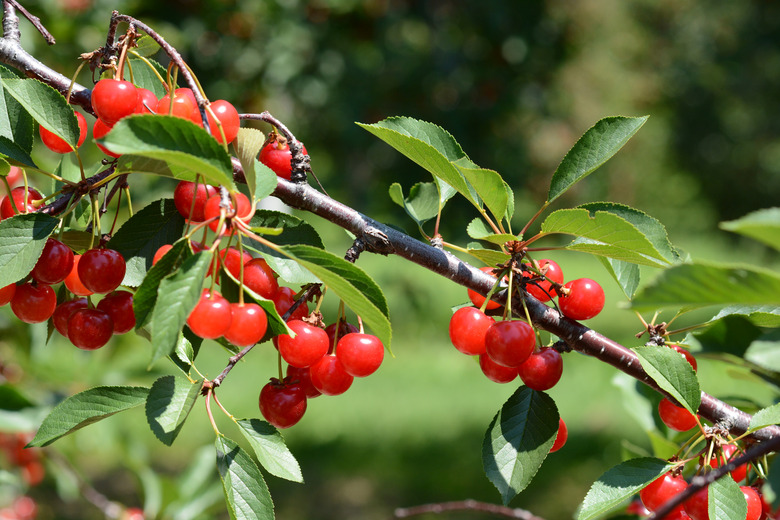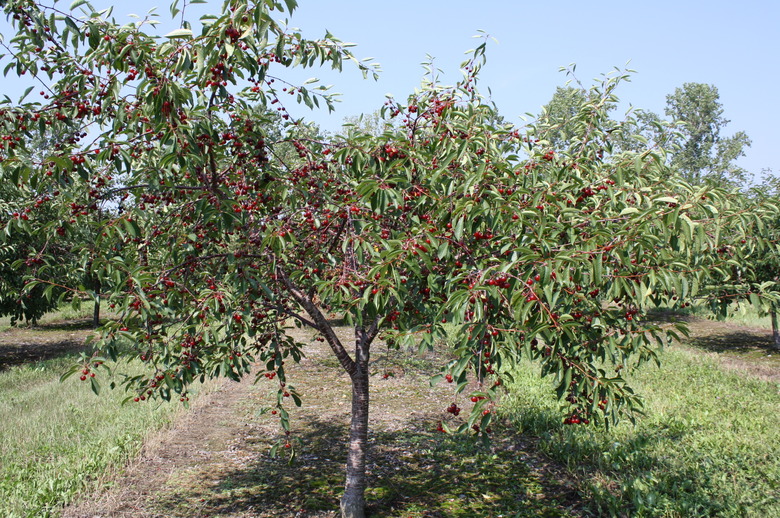Cultivars Of Sour Cherry Trees
Fruit-bearing cherry trees (Prunus spp.) are divided into two main groups: sweet cherries (Prunus avium) and sour cherries (Prunus cerasus), also known as tart cherries. Sweet cherries are usually consumed fresh; however, the tartness of sour cherries makes them better suited for baking and jam-making.
The sour cherry tree cultivars on the market produce fruit that vary in size, color, flavor and harvest time.
Sour Cherry Cultivars
| Cultivar | Type | Highlights |
| Montmorency | Amarelle | Most popular sour cherry in the U.S. |
| Meteor | Amarelle | Semi-dwarf; very hardy |
| Early Richmond | Amarelle | Early ripening; large fruit |
| North Star | Morello | Dwarf; very hardy |
| Balaton | Morello | Native to Hungary; large fruit |
| Danube | Morello | Native to Hungary; sweet fruit |
Sour Cherry Cultivars vs. Varieties
Cultivars (short for "cultivated varieties") are plants created and maintained by horticulturists that do not produce true-to-seed, whereas varieties are groups of plants within a species with certain distinguishing characteristics that commonly produce true-to-seed.
Since all of the plants discussed in this article are cultivars, they will be referred to as such instead of as varieties.
Characteristics of the Sour Cherry
There are notable differences between sweet and sour cherry trees. While most sweet cherry tree cultivars must be cross-pollinated by a different compatible cultivar in order to produce fruit, sour cherry trees are able to self-pollinate. That means they can set fruit with their pollen.
However, to improve the quality of the crop, cross-pollination between two different cultivars is preferable. Sour cherry trees are generally more tolerant of cold temperatures than sweet cherry trees.
Sour cherries, explains The Ohio State University, are divided into two groups: Amarelle cherries, which have paler or outright yellow flesh and produce a lighter, sometimes clear juice, and Morello cherries, which have both red flesh and red juice.
Amarelle Sour Cherry Tree Cultivars
Montmorency
According to the Arbor Day Foundation, the overwhelming majority of sour cherries grown in the U.S.—as many as 95 percent—are Montmorency cherries, which fall into the Amarelle category. Montmorency is commonly the sour cherry of choice for pies.
Hardy in U.S. Department of Agriculture plant hardiness zones 4 to 7, standard Montmorency cherry trees have a height of around 18 feet tall, though there is a dwarf version that maxes out at around 8 feet.
Meteor
Other types of Amarelle cherries include Meteor, a cultivar introduced by the University of Minnesota that yields large fruit that the Ohio State University describes as mildly acidic to the taste.
Meteor is a semi-dwarf cherry tree with a height between 10 and 14 feet, per Iowa State University Extension and Outreach.
Early Richmond
The Early Richmond sour cherry cultivar gets its name because it ripens about a week earlier in June than other tart cherries used for pies. This tart cherry tree cultivar comes in standard 18-foot-tall versions as well as a dwarf option.
The Arbor Day Foundation describes the fruit of Early Richmond as a medium size with thin, light red skin. This cultivar is hardy in USDA zones 4-8.
Morello Sour Cherry Tree Cultivars
North Star
The North Star sour cherry tree produces a Morello type of fruit, and like Meteor, it was introduced by the University of Minnesota. It is a dwarf tree of sour cherry with a height between 8 and 10 feet.
Along with Meteor, it is one of the most cold-hardy tart cherry trees for sale.
Danube
With a higher sugar content than most other types of sour cherries that makes it sweet and therefore better suited for eating fresh, Danube cherry trees are native to Hungary, and this cultivar is growing in popularity in Europe, according to the Virginia Cooperative Extension.
The fruit of the Danube cherry tree cultivar may be medium or large and is a deep red color.
Balaton
Like the Danube cherry, the trademarked Balaton cherry tree is native to Hungary. This tree was introduced in the U.S. in the 1980s by a professor at Michigan State University. It produces large, burgundy-colored fruits that are firm to the touch.
References
- Arbor Day Foundation: Montmorency Cherry
- Ohio State University: Cherries – Varieties
- University of Missouri Extension: Fruit Cultivars for Home Plantings
- Iowa State University Extension and Outreach: Yard and Garden: Cherry Trees
- Michigan State University: Balaton Cherries
- Arbor Day Foundation: Early Richmond Cherry
- Virginia Cooperative Extension: Growing Cherries in Virginia

